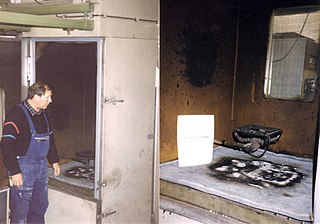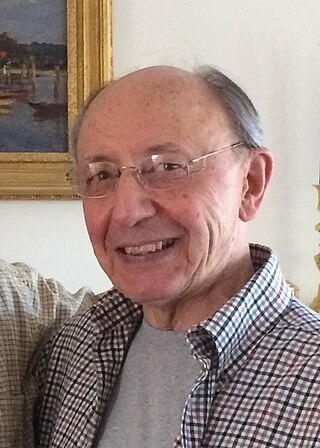Bromotrifluoromethane, commonly referred to by the code numbers Halon 1301, R13B1, Halon 13B1 or BTM, is an organic halide with the chemical formula CBrF3. It is used for gaseous fire suppression as a far less toxic alternative to bromochloromethane.

The National Electrical Code (NEC), or NFPA 70, is a regionally adoptable standard for the safe installation of electrical wiring and equipment in the United States. It is part of the National Fire Code series published by the National Fire Protection Association (NFPA), a private trade association. Despite the use of the term "national", it is not a Federal law. It is typically adopted by states and municipalities in an effort to standardize their enforcement of safe electrical practices. In some cases, the NEC is amended, altered and may even be rejected in lieu of regional regulations as voted on by local governing bodies.
The publication Life Safety Code, known as NFPA 101, is a consensus standard widely adopted in the United States. It is administered, trademarked, copyrighted, and published by the National Fire Protection Association and, like many NFPA documents, is systematically revised on a three-year cycle.
Evacuation simulation is a method to determine evacuation times for areas, buildings, or vessels. It is based on the simulation of crowd dynamics and pedestrian motion. The number of evacuation software have been increased dramatically in the last 25 years. One of the latest survey indicate the existence of over 70 pedestrian evacuation models. Today there are two conferences dedicated to this subject: "Pedestrian Evacuation Dynamics" and "Human Behavior in Fire".

A fire sprinkler or sprinkler head is the component of a fire sprinkler system that discharges water when the effects of a fire have been detected, such as when a predetermined temperature has been exceeded. Fire sprinklers are extensively used worldwide, with over 40 million sprinkler heads fitted each year. In buildings protected by properly designed and maintained fire sprinklers, over 99% of fires were controlled by fire sprinklers alone.
Fire protection engineering is the application of science and engineering principles to protect people, property, and their environments from the harmful and destructive effects of fire and smoke. It encompasses engineering which focuses on fire detection, suppression and mitigation and fire safety engineering which focuses on human behavior and maintaining a tenable environment for evacuation from a fire. In the United States 'fire protection engineering' is often used to include 'fire safety engineering'.
NFPA 70E(Standard for Electrical Safety in the Workplace) is a standard of the National Fire Protection Association (NFPA). The document covers electrical safety requirements for employees. The NFPA is best known for publishing the National Electrical Code.
Engineering ethics is the field of system of moral principles that apply to the practice of engineering. The field examines and sets the obligations by engineers to society, to their clients, and to the profession. As a scholarly discipline, it is closely related to subjects such as the philosophy of science, the philosophy of engineering, and the ethics of technology.
In electrical engineering, low voltage is a relative term, the definition varying by context. Different definitions are used in electric power transmission and distribution compared with electronics design. Electrical safety codes define "low voltage" circuits that are exempt from the protection required at higher voltages. These definitions vary by country and specific codes or regulations.

A combustible material is a material that can burn in air under certain conditions. A material is flammable if it ignites easily at ambient temperatures. In other words, a combustible material ignites with some effort and a flammable material catches fire immediately on exposure to flame.
The NFPA 72 is a standard published by the National Fire Protection Association every 3 years for installation of fire alarm systems and emergency communication systems in the United States.

Fire Technology is a peer-reviewed journal publishing scientific research dealing with the full range of actual, possible, and potential fire hazards facing humans and the environment. It publishes original contributions, both theoretical and empirical, that contribute to the solution of problems in fire safety and related fields. It is published by Springer in conjunction with the National Fire Protection Association and the Society of Fire Protection Engineers.

David Allen Lucht is an American engineer and fire safety expert. His career was devoted to public service in government, academia and the nonprofit sector. He served as the Ohio State Fire Marshal; the first presidential appointee to serve in the United States Fire Administration and the inaugural head of the graduate degree fire protection engineering program at Worcester Polytechnic Institute, where he served for 25 years

The NIST World Trade Center Disaster Investigation was a report that the National Institute of Standards and Technology (NIST) conducted to establish the likely technical causes of the three building failures that occurred at the World Trade Center following the September 11, 2001 terrorist attacks. The report was mandated as part of the National Construction Safety Team Act, which was signed into law on October 1, 2002 by President George W. Bush. NIST issued its final report on the collapse of the World Trade Center's twin towers in September 2005, and the agency issued its final report on 7 World Trade Center in November 2008.
James G. Quintiere is an American mechanical engineer known for his work on fire protection engineering and fire safety. He is professor emeritus in the Department of Fire Protection Engineering at the University of Maryland's A. James Clark School of Engineering. A noted expert on arson, he has testified in criminal trials regarding the causes of certain fires, such as the one that occurred in the Waco siege and killed over 80 people. He has also studied the causes of the collapse of the World Trade Center, concluding that it was probably caused by faulty fireproofing.

Erica Kuligowski is an american social research scientist investigating human behavior during emergencies and the performance of evacuation models in disasters. She currently works at RMIT university in Melbourne (Australia). Kuligowski used to work the Engineering Lab of the National Institute of Standards and Technology conducting research on several fire disasters including the NIST Hurricane Maria Project.

Guillermo Rein is a professor of fire science in the Department of Mechanical Engineering at Imperial College London. His research is focused on fire, combustion, and heat transfer. He is the editor-in-chief of the journal Fire Technology and Fellow of the Combustion Institute.

Jensen Hughes is a professional engineering and consulting services company headquartered in Baltimore that provides services, software, and consulting in fire protection engineering, forensic engineering, and security. The company has approximately 90 offices globally in part due to its acquisitions of and mergers with related safety and security middle-market companies in recent years. As of 2019, it has been led by CEO Raj Arora. The company's projects include conducting forensic investigations of fire accident scenes on behalf of local courts, studying fire dynamics of chemicals with the National Institute of Justice, and working with healthcare associations to stock local clinical practices and hospitals with PPE and other medical supplies.

Margaret Law was a British engineer and pioneer in the field of fire science and fire safety engineering who became one of the world's leading fire scientists. In 1971, she was the first woman to become a member of the Institution of Fire Engineers, and has been described as representing 'the epitome of placing applied and rigorous technical excellence at the heart of the design and construction of the built environment'.

Ruggiero Lovreglio is an Italian academic. He is an associate professor at Massey University and a Rutherford Discovery Fellow for Royal Society Te Apārangi. His research is focused on large-scale and small-scale evacuation dynamics and safety training using emerging technologies, such as virtual reality and augmented reality.











